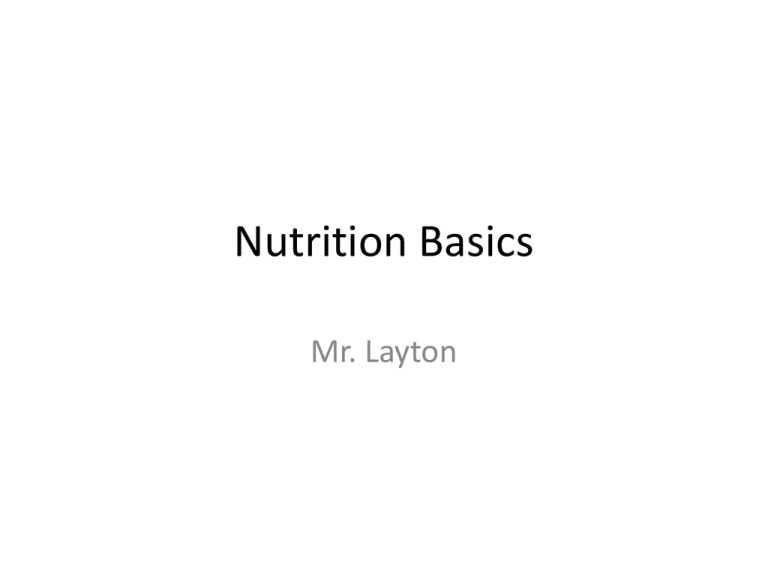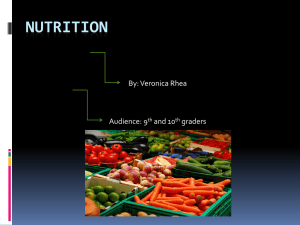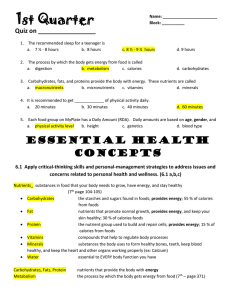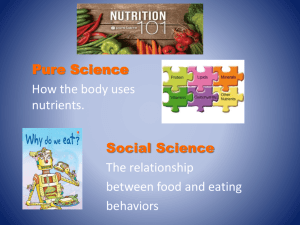Nutrition Basics Mr. Layton
advertisement

Nutrition Basics Mr. Layton Calorie content ??? • One plain bagel • 150 calories • 1 cup of chocolate milk • 1 slice of apple pie • 180 calories • 1 cup cooked spaghetti • 1 stalk of celery • 210 • 155 • 1 can of regular coke • 1 quarter-pound hamburger with cheese • 5 • 1 pear • 100 • 520 • 405 WHY DO WE EAT??? The foods you eat are your body’s chief source of nutrients! Basic need What is the difference between hunger and appetite??? _____________– is a desire to eat, rather than a need. ____________ is the need to eat Why do you eat the foods that you do???? • Environment – 1. ___________- your food choices reflect the culture you live in, as well as your ethnic background, etc. 2. Your ___________________ 3. _________________ 4. Time and money –taste and nutrition are the two top factors that influence food shopping decisions. 5. _____________– bored, stressed, depressed… Eating habits Why is eating linked to six out of ten leading causes of death in the US, including heart disease, stroke, and cancer? People are unable to distinguish between _____________________! – You eat past the point of feeling full because your appetite continues to be stimulated after your hunger is past. – Usually with a ____________! Teens and Nutrition • Good nutrition is essential during your teen-age years – F_____________________ – Provides you with: • N________________________ • Calories- ____________________ • ____________- substances in food that helps your body grow, repair itself and provides energy Teens and Nutrition Choices • Eating patterns now are likely to continue later in life • Developing good eating patterns can prevent: – – – – – – – O____________ Diabetes S__________ Cancers Osteoporosis H________________ High Blood pressure Nutrition Label Basics • Food labels indicates the nutrients and calorie content of foods • Each label contains: 1. ______________size 2. serving per ___________ 3. grams of total fat, saturated fat, total carbohydrates, fiber, sugars, protein, milligrams of cholesterol and sodium _________________ The first ingredient listed on the label is the ingredient with the heaviest wt. Digestive System • Digestion – Process of breaking down large foods into smaller molecules of nutrients to be absorbed into the blood and carried to cells throughout the body. • Nutrition – the process in which the body takes in and uses food •http://www.umm.edu/digest/howworks.htm Food and Energy • When your body uses the _________ in foods, a series of chemical reactions take place inside your cells. As a result, energy is _______________. • The amount of energy released when nutrients are burned is measured in units called ___________. The more calories a food has, the more _________ it _______________. Energy is needed for such things as: • Regulating body ______________ • Keeping your heart beating and your longs breathing • Keeping your _________ _________ • Everything that you do! 6 Classes of Nutrients • Through Digestion, nutrients serve ______ functions: – Provide Energy (Macro nutrients) • Carbohydrates (1) • Proteins (2) • Fats (3) – Regulating Growth and Repair of Tissues • Proteins – Regulate Body Functions (Micro nutrients) • Vitamins (4) • Minerals (5) • Water (6) 6 Classes Of Nutrients Through digestion, Nutrients serve 3 functions: 6 Nutrients Build and Repair Body Cells Provide Energy CHO’s Fats Proteins Proteins Regulate Body Functions Vitamins Minerals Water Energy Providing Nutrients • Carbohydrates – ____ calories/gram • Proteins – ____ calories/gram • Fats – ____ calories/gram • The rate at which we burn energy is determined by things such as: • How active we are • Our age • One’s own basil metabolic rate • The temperature of the environment 1. Carbohydrates (CHO’s) • Major source of ________ for the body – Role of CHO’s: • – Unused CHO’s can be stored: • • • – Turned into glucose (Sugar) that the body uses to produce energy Glycogen- Stored glucose in liver or muscles Fat- Excess CHO’s that can’t be stored as glycogen are stored as FAT Can be used for energy when the body needs it _________ of food should be Carbohydrates Simple and Complex CHO’s • There are ___ types of carbohydrates: – __________ carbohydrates (Sugars) • Used for quick, immediate energy • Examples: fruits (fructose), some vegetables (maltose), milk (lactose), sugars found in desert foods (no nutritional value) • MYTH: Eat sugar to boost your energy. – FACT: Your blood glucose level peaks initially, but wears off quickly and below normal levels Sugary carbohydrates found in soft drinks, and candy =empty calories Simple sugars = quick burst of energy followed by a __________feeling Eating of sugary foods causes the pancreas to secrete an ______________ of insulin in response to the rise in blood glucose level. Result – within an hour of eating, the body feels ______________________________ Simple and Complex CHO’s – Complex carbohydrates (Starches) • Used to supply long-lasting energy • Eating more whole grain CHO’s will cause fewer sugar cravings since CHO’s are a natural source of sugar. If the body does not get enough whole grain CHO’s then it will _______sugary snacks like candies, cakes, etc. • Look for foods that contain at least ____ grams of fiber per serving. • Exa. Of whole grains: bread, cereals, pasta, potatoes, fruit, starchy vegetables – FACT: This provides a slow release of glucose over time (Sustained energy) Fiber in carbohydrates • _________ is the tough, stringy part of vegetables, fruits, and grains • Complex carbohydrate found in plants • Fiber is not really a ________ because it cannot be broken down and absorbed into the body – they pass out of the body without being digested. However… • Fiber prevents ____________, and may reduce the risk of lower bowel cancer and play a role in preventing heart disease • __________ grain bread and cereals, vegetables, fruits, and seeds provide fiber • 25 grams of fiber is needed daily Fiber- A Unique CHO • Fiber – Indigestible type of complex carbohydrate – Does not provide Energy – Function: • Helps move waste through digestive system • Helps prevents constipation, heart disease, diabetes and cancers – Eat 20-35 grams of fiber daily 2. Fat (Lipids) • Role of Fat: is the nutrient that gives us the highest energy – Provides a lot of ____________ in long lasting activities – They help you absorb fat soluble vitamins A,D,E, and K • Aerobic Activities tend to burn BODY FAT Saturated Fats • 2 Types – _____________ Fats • Tend to be more solid in room temp. • Found in ________ _____ and _____ • Leading sources in American diet include: red meat, whole milk, cheese, hot dogs, and lunch meats. • Linked to _________________ because it increases levels of cholesterol • When possible, substitute low-fat foods such as skim milk and low fat cheeses. Unsaturated Fats Are healthy and needed in the body! • Unsaturated Fats – Liquid in _________ temp. – Usually from plant sources: “Oils” such a olive oil, canola oil, nuts, seeds, fish oil – Reduced risk of __________________ – Good fats: olives and olive oil, peanut butter, nuts, canola oil, flaxseed and flaxseed oil. Hydrogenated Oils • Process by which hydrogens are added to unsaturated fats solid fats • Turning some unsaturated fatty acids to trans fatty acids • Used to improve texture and stability • Very _______________ fat- stay away from trans fat! • Raise LDL’s Lower HDL’s Cholesterol • Fatlike substance produced in _______ – Found in all animal meat – Adequate cholesterol is essential for many bodily functions, however, too much can cause problems • Atherosclerosis – Disease where ___________ builds up in artery causing it to _____________ Ways to • • • • HDL’S _____________Activity Avoid Trans fatty acids Don’t / quit smoking Replace saturated fats w/ unsaturated 3. Protein (PRO) • Role of Protein: – Help to build __________ during growth – Replace damaged cells throughout life – They are the primary component of the brain, heart, blood, skin and hair. – Provide energy in times of extreme need – Ex: meat, beans, fish, chicken (not fried) 4. Vitamins • DO NOT PROVIDE __________ • Vitamins are compounds that allow many of the ___________ processes in the body to occur. • Almost all vitamins must come from food or supplements Types of Vitamins • Two Groups of Vitamins – Fat-soluble vitamins: Vits. A, D, E, K • _____________________ • Utilized when needed – Can be toxic if taken in large amounts – Water soluble vitamins: Vits B and C • • • • • ________________ Not stored in body Excreted in Urine Must be replaced often Nine H2O soluble vitamins 5. Minerals • • • Inorganic substances the body cannot produce Come from the _________________ Functions: – Speed reactions in body to regulate process of the body: healing wounds, facilitating muscle contraction, providing major components of bones. • 2 types of Minerals Trace Elements • Only needed in __________ amounts • Ex. Iron, Copper, iodine, selenium, zinc.. – Each mineral has a different purpose • Iron- carries oxygen in blood • Zinc- boosts immune system Major Elements • Needed in large quantities • Ex. Calcium, Potassium, Sodium, Chloride… – Each mineral has a different purpose • Calcium- Develop bone strength, muscle contractions, blood clotting. In the teen years you are still building bone mass, so it is essential that you get enough calcium each day. (4-6 servings) Each can of pop that you drink robs the body of 100mg of calcium.) • Teens can store calcium in their teen years • In the adult years, the body uses more calcium than it makes, so it is important that you drink 3-4 cups of milk, or eat products containing calcium daily! • If your body lack calcium, it will take from the jaw bone first! • Sodium, Chloride and Potassium- Electrolytes that maintain body fluid 6. Water • _____________of body weight is water • Function: – – – – – – • Carries nutrients to and from cells (Plasma) Lubricates joints Allows you to swallow and digest foods Allows you to absorb nutrients Eliminates wastes Regulate body temperature Should drink fluids often (____ cups/day) Other Hydration tips for athletes • Drink 16 ounces of liquid two hours before the event. • Drink 4-8 ounces of liquid for every fifteen minutes of exercise to minimize dehydration. • Weigh yourself before and after the event to learn how much fluid is lost in sweat, then drink freely to replace it. • Remember, just because you don’t feel thirsty it doesn’t mean you don’t need to drink. • Cold-weather athletes (skiers) may not experience the buildup of heat as quickly as summer soccer players, yet they still need to replace their fluids, so do it! The benefits of breakfast • Breakfast is important for ___________ the body after a night’s sleep. • Improves your ability to ________________ during class. Children who eat breakfast score higher in standardized test scores. They also are more _______________ • Prevents low blood sugar which causes fatigue • Improves one’s ability to _____________. Children who skip breakfast are almost _________ as likely to become overweight. Energy drinks • Are soft drinks that promise to give your body a boost of energy • Major components in energy drinks are sugar and caffeine • Energy drinks often contain amounts of caffeine higher than the maximum amount that the FDA allows in cola beverages. • Caffeine is a natural diuretic (loss of water) • Sugar makes you feel drowsy in about 1 hr. Does not really energize you! Energy Drinks Beverage Caffeine (mg) 65 -120 Calories Coffee Serving Size 8 oz. Red Bull 8.3 66.7 115 Amp 8.3 69.6 114 Amazon Energy Mountain Dew 8.3 100 12 oz 45.4 0 165 Energy drinks Beverage Blow Extreme Energy 6 hour shot Serving size 8 caffeine 2 scoops 220 240 sugar Side effects of caffeine • • • • • Headaches Anxiety Increased heart rate Increased blood pressure insomnia Sport drinks • Can be helpful for athletes who are exercising for 60 minutes or more • They replace carbohydrates and electrolytes • Athletes need to stay hydrated for optimal performance. Don’t “wait” untiol you are thirsty.



